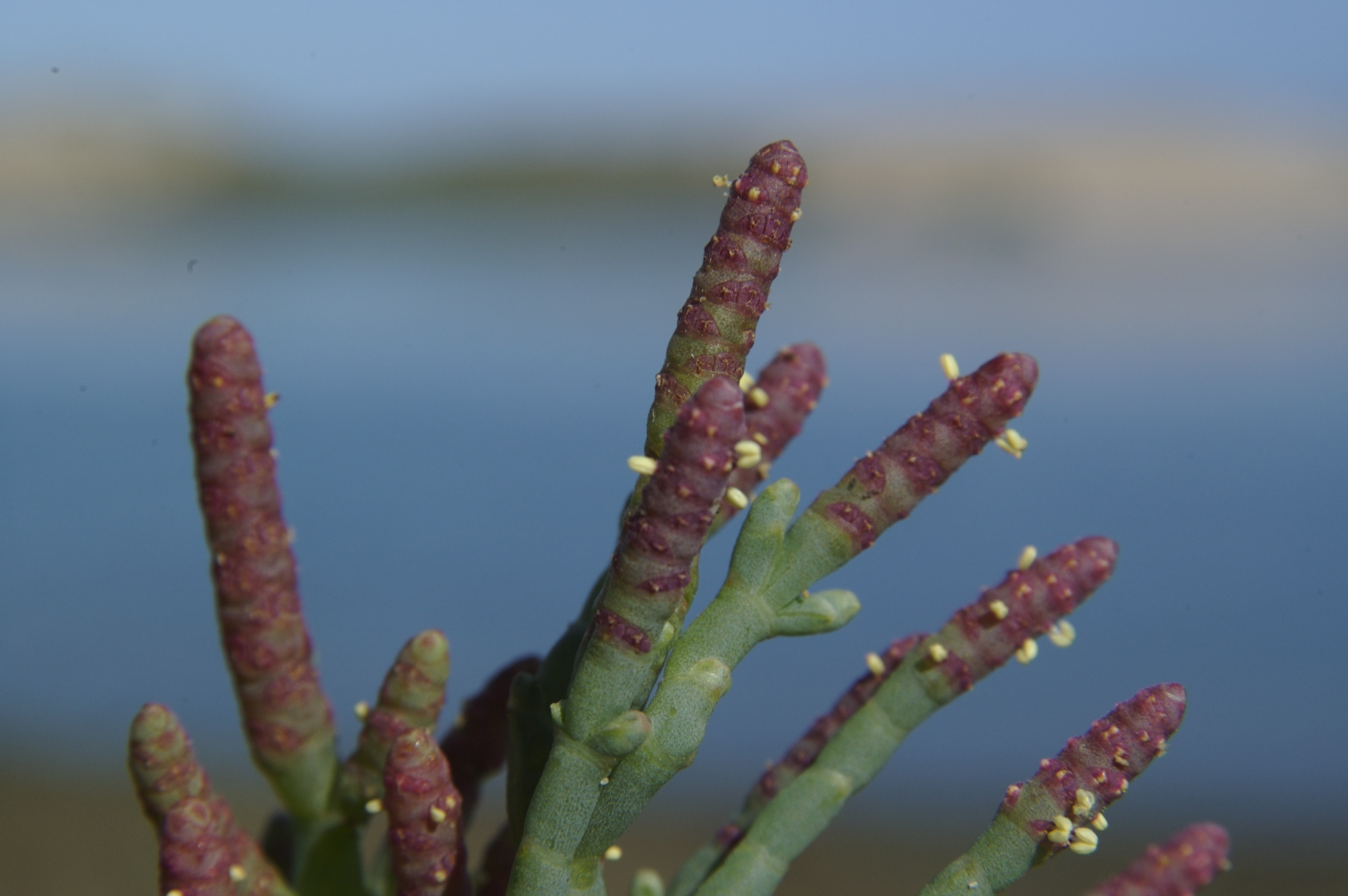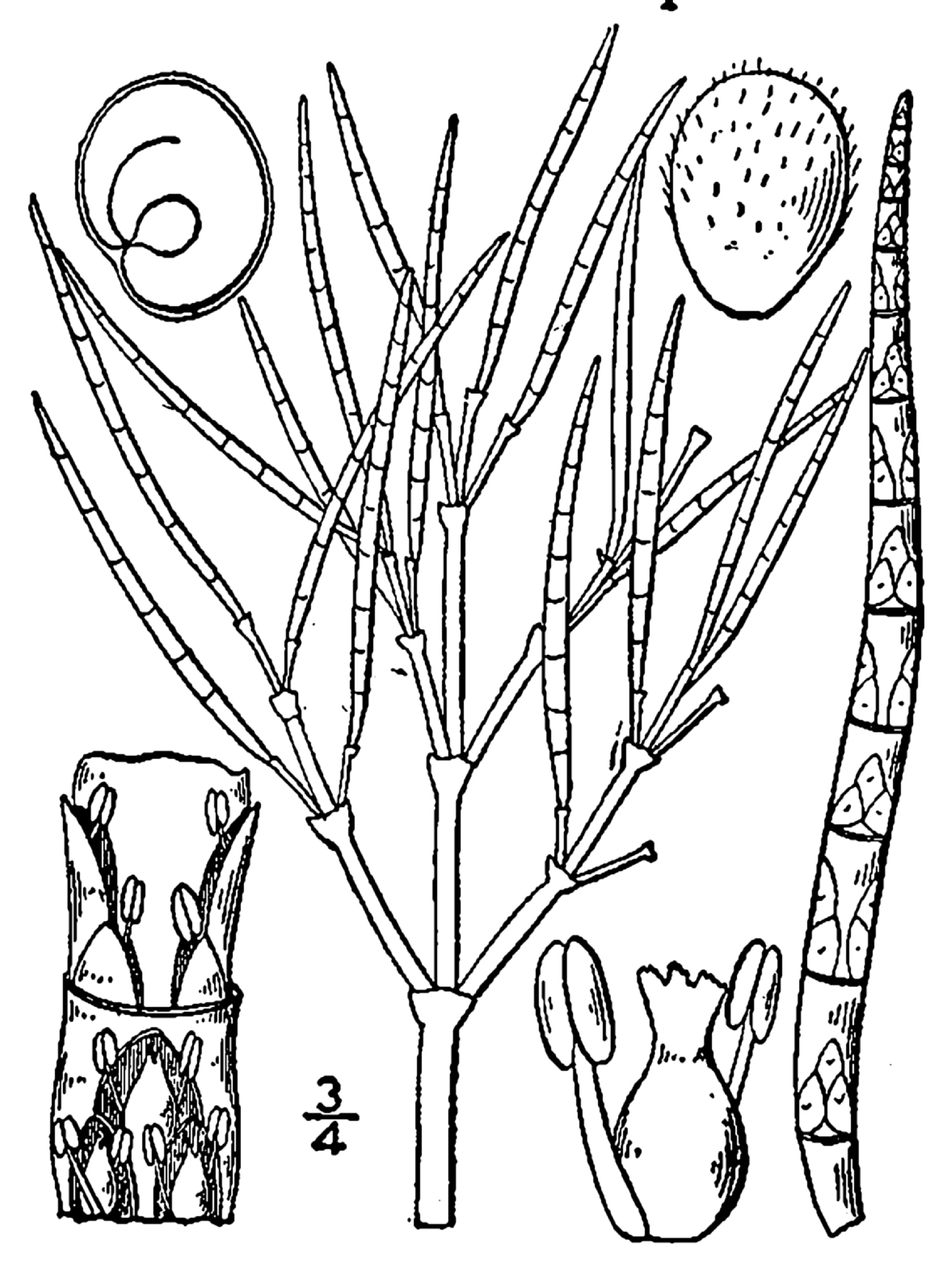|
Sarcocornia
''Sarcocornia'' is a formerly recognized genus of flowering plants in the amaranth family, Amaranthaceae. Species are known commonly as samphires, glassworts, or saltworts. Molecular phylogenetic studies have shown that when separated from ''Salicornia'', the genus is paraphyletic, since ''Salicornia'' is embedded within it, and ''Sarcocornia'' has now been merged into a more broadly circumscribed ''Salicornia''. When separated from ''Salicornia'', the genus has a cosmopolitan distribution, and is most diverse in the Cape Floristic Region of South Africa. Description Species formerly placed in ''Sarcocornia'' are perennial herbs, subshrubs or shrubs. They are taking an erect or prostrate, creeping form. The new stems are fleshy and divided into joint-like segments. Older stems are woody and not segmented. The oppositely arranged leaves are borne on fleshy, knobby petioles, their base decurrent and connate (thus forming the segments), the blades forming small, triangular t ... [...More Info...] [...Related Items...] OR: [Wikipedia] [Google] [Baidu] |
Salicornia Perennis
''Salicornia perennis'', synonym ''Sarcocornia perennis'', otherwise known as perennial glasswort, is a species of halophytic perennial plant within the family Amaranthaceae Amaranthaceae is a family of flowering plants commonly known as the amaranth family, in reference to its type genus ''Amaranthus''. It includes the former goosefoot family Chenopodiaceae and contains about 165 genera and 2,040 species, making it .... It has a widespread but patchy native distribution, being found in parts of Western Europe, northern and southern Africa, North America from southeast Alaska to south Mexico, the Caribbean, and South America. It is native to the coasts of southern Britain and Ireland, where it is classified as nationally scarce. The species flowers between July and October. References perennis Flora of Southwestern Europe Flora of Southeastern Europe Flora of Africa Flora of North America Flora of South America {{Amaranthaceae-stub ... [...More Info...] [...Related Items...] OR: [Wikipedia] [Google] [Baidu] |
Salicornia Blackiana
''Salicornia blackiana'', synonym ''Sarcocornia blackiana'', commonly known as thick-head glasswort, is a species of succulent halophytic shrub. It is widespread in southern and western Australia, including Tasmania. Its preferred habitats are estuaries, swamps and periodically waterlogged saline areas. Description It grows as an erect or decumbent perennial herb with succulent, stem-like leaves, growing up to 0.8 m in height. It is very similar to the better known beaded glasswort ''Salicornia quinqueflora'', synonym ''Sarcocornia quinqueflora'', commonly known as beaded samphire, bead weed, beaded glasswort or glasswort, is a species of succulent halophytic coastal shrub. It occurs in wetter coastal areas of Australia ... but is a larger plant and differs in having a thicker fruiting spike, 4–9 mm in diameter, and seeds with blunt hairs or papillae. References External links * blackiana Flora of Tasmania Flora of New South Wales Flora of Victo ... [...More Info...] [...Related Items...] OR: [Wikipedia] [Google] [Baidu] |
Salicornia Decumbens
''Salicornia'' is a genus of succulent, halophytic (salt tolerant) flowering plants in the family Amaranthaceae that grow in salt marshes, on beaches, and among mangroves. ''Salicornia'' species are native to North America, Europe, Central Asia, and southern Africa. Common names for the genus include glasswort, pickleweed, picklegrass, and marsh samphire; these common names are also used for some species not in ''Salicornia''. To French speakers in Atlantic Canada, they are known colloquially as ''titines de souris'' ('mouse tits'). The main European species is often eaten, called marsh samphire in Britain, and the main North American species is occasionally sold in grocery stores or appears on restaurant menus as sea beans, samphire greens or sea asparagus. Description The ''Salicornia'' species are small annual herbs. They grow prostrate to erect, their simple or branched stems are succulent, hairless, and appear to be jointed. The opposite leaves are strongly reduced to sma ... [...More Info...] [...Related Items...] OR: [Wikipedia] [Google] [Baidu] |
Salicornia Capensis
''Salicornia'' is a genus of succulent, halophytic (salt tolerant) flowering plants in the family Amaranthaceae that grow in salt marshes, on beaches, and among mangroves. ''Salicornia'' species are native to North America, Europe, Central Asia, and southern Africa. Common names for the genus include glasswort, pickleweed, picklegrass, and marsh samphire; these common names are also used for some species not in ''Salicornia''. To French speakers in Atlantic Canada, they are known colloquially as ''titines de souris'' ('mouse tits'). The main European species is often eaten, called marsh samphire in Britain, and the main North American species is occasionally sold in grocery stores or appears on restaurant menus as sea beans, samphire greens or sea asparagus. Description The ''Salicornia'' species are small annual herbs. They grow prostrate to erect, their simple or branched stems are succulent, hairless, and appear to be jointed. The opposite leaves are strongly reduced to sma ... [...More Info...] [...Related Items...] OR: [Wikipedia] [Google] [Baidu] |
Salicornia
''Salicornia'' is a genus of succulent, halophytic (salt tolerant) flowering plants in the family Amaranthaceae that grow in salt marshes, on beaches, and among mangroves. ''Salicornia'' species are native to North America, Europe, Central Asia, and southern Africa. Common names for the genus include glasswort, pickleweed, picklegrass, and marsh samphire; these common names are also used for some species not in ''Salicornia''. To French speakers in Atlantic Canada, they are known colloquially as ''titines de souris'' ('mouse tits'). The main European species is often eaten, called marsh samphire in Britain, and the main North American species is occasionally sold in grocery stores or appears on restaurant menus as sea beans, samphire greens or sea asparagus. Description The ''Salicornia'' species are small annual herbs. They grow prostrate to erect, their simple or branched stems are succulent, hairless, and appear to be jointed. The opposite leaves are strongly reduced to sma ... [...More Info...] [...Related Items...] OR: [Wikipedia] [Google] [Baidu] |
Salicornia Andina
''Salicornia'' is a genus of succulent, halophytic (salt tolerant) flowering plants in the family Amaranthaceae that grow in salt marshes, on beaches, and among mangroves. ''Salicornia'' species are native to North America, Europe, Central Asia, and southern Africa. Common names for the genus include glasswort, pickleweed, picklegrass, and marsh samphire; these common names are also used for some species not in ''Salicornia''. To French speakers in Atlantic Canada, they are known colloquially as ''titines de souris'' ('mouse tits'). The main European species is often eaten, called marsh samphire in Britain, and the main North American species is occasionally sold in grocery stores or appears on restaurant menus as sea beans, samphire greens or sea asparagus. Description The ''Salicornia'' species are small annual herbs. They grow prostrate to erect, their simple or branched stems are succulent, hairless, and appear to be jointed. The opposite leaves are strongly reduced to sma ... [...More Info...] [...Related Items...] OR: [Wikipedia] [Google] [Baidu] |


